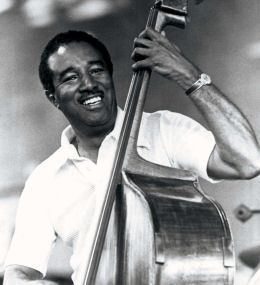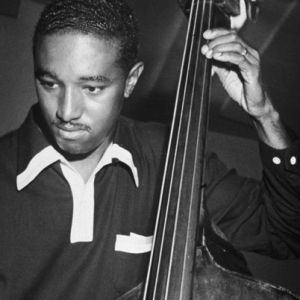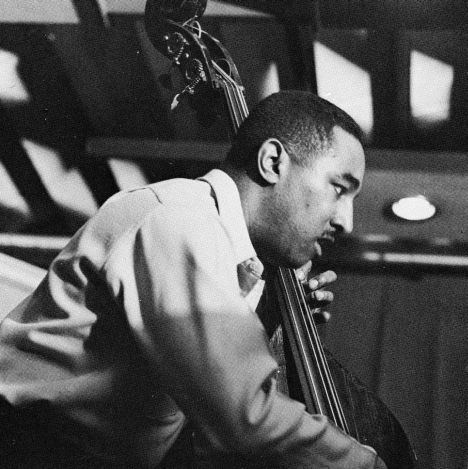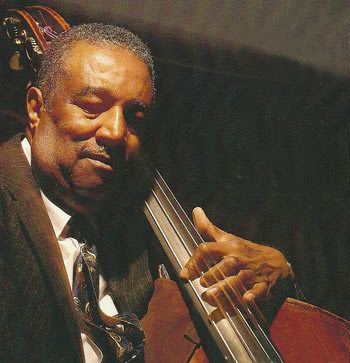Years active 1946-2002 Name Ray Brown | Occupation(s) Musician, composer Role Bassist Instruments Double bass, cello Children Ray Brown, Jr. | |
 | ||
Born October 13, 1926Pittsburgh, Pennsylvania, U.S. ( 1926-10-13 ) Albums Ray Brown / Milt Jackson, SuperBass, This One's for Blanton!, Jazz Cello, SuperBass 2 | ||
Birth name Raymond Matthews Brown Similar James Morrison (jazz musician), Don Burrows, Joe Chindamo | ||
respect your fellow musicians ray brown chuck rainey tommy tedesco michel legrand
Raymond Matthews "Ray" Brown (October 13, 1926 – July 2, 2002) was an American jazz double bassist and cellist, known for extensive work with Oscar Peterson and Ella Fitzgerald, among others.
Contents
- respect your fellow musicians ray brown chuck rainey tommy tedesco michel legrand
- Early life
- Career
- Later career
- Private life
- Awards and honors
- Grammys
- References

Early life

Ray Brown was born in Pittsburgh, Pennsylvania and took piano lessons from the age of eight. After noticing how many pianists attended his high school, he thought of taking up the trombone but was unable to afford one. With a vacancy in the high school jazz orchestra, he took up the upright bass.
Career

A major early influence on Brown's bass playing was Jimmy Blanton, the bassist in the Duke Ellington band. As a young man Brown became increasingly well known in the Pittsburgh jazz scene, with his first experiences playing in bands with the Jimmy Hinsley Sextet and the Snookum Russell band. After graduating high school, having heard stories about the burgeoning jazz scene on 52nd Street in New York City, he bought a one-way ticket to New York. He arrived in New York at the age of 20, met up with Hank Jones, with whom he had previously worked, and was introduced to Dizzy Gillespie, who was looking for a bass player. Gillespie hired Brown on the spot, and he soon played with such established musicians as Art Tatum and Charlie Parker. In 1948, Brown left Dizzy's band to start a trio with Hank Jones and Charlie Smith.

From 1946 to 1951 Brown played in Gillespie's band. Brown, along with the vibraphonist Milt Jackson, drummer Kenny Clarke, and pianist John Lewis formed the rhythm section of the Gillespie band. Lewis, Clarke, and Jackson eventually formed the Modern Jazz Quartet. Brown became acquainted with singer Ella Fitzgerald when she joined the Gillespie band as a special attraction for a tour of the southern United States in 1947. The two married that year, and together they adopted a child born to Fitzgerald's half-sister Frances, whom they christened Ray Brown, Jr. Fitzgerald and Brown divorced in 1953, bowing to the various career pressures both were experiencing at the time, though they would continue to perform together.
Around this time Brown was also appearing in Jazz at the Philharmonic concerts, organized by Norman Granz. It was at a Jazz at the Philharmonic concert in 1949 that Brown first worked with the jazz pianist Oscar Peterson, in whose trio Brown would play from 1951 to 1966. Between 1957 and 1959, Brown appeared on Blossom Dearie's first five recordings for Verve Records. After leaving the Trio he became a manager and promoter as well as a performer. In 1966, he settled in Los Angeles, where he was in high demand working for various television show orchestras. He also accompanied some of the leading artists of the day, including Tony Bennett, Billy Eckstine, Frank Sinatra, Sarah Vaughan, and Nancy Wilson. He also managed his former musical partners, the Modern Jazz Quartet, as well as a young Quincy Jones, produced some shows for the Hollywood Bowl, wrote jazz bass instruction books, and developed a jazz cello. Also in Los Angeles he composed music for films and television shows.
Later career
From 1974 to 1982, Brown performed and recorded a series of albums with guitarist Laurindo Almeida, saxophonist and flautist Bud Shank, and drummer Shelly Manne (replaced by Jeff Hamilton after 1977) under the name The L.A. Four. He also joined up with Milt Jackson again to record the classic Jackson, Johnson, Brown & Company (1983), featuring Jackson and Brown with J. J. Johnson on trombone, Tom Ranier on piano, guitarist John Collins, and drummer Roy McCurdy.
Brown guested as a bass player on "Razor Boy", the second track on Steely Dan's second album, Countdown to Ecstasy, released in 1973.
Brown appeared on four tracks from the soundtrack to Clint Eastwood's biopic about Charlie Parker, titled Bird (1988). Although all of the saxophone parts are Bird's original playing, the accompaniment was re-recorded in order to beef up the sound, using Brown and, among others, John Guerin on drums.
In the 1980s and 1990s Brown led his own trios and continued to refine his bass playing style. In his later years he recorded and toured extensively with pianist Gene Harris. In the early 1980s, Brown met Diana Krall in a restaurant in Nanaimo, British Columbia. According to Jeff Hamilton, in an interview recorded on the Diana Krall Live in Rio DVD, he first heard Krall play at a workshop and, impressed with her piano skills (she was not yet singing), introduced her to bassist John Clayton. Hamilton and Clayton both encouraged Krall to move to Los Angeles to study under Brown and others. In 1990, he teamed up with pianist Bobby Enriquez and drummer Al Foster, for Enriquez's album, The Wildman Returns. During 1990–93 the "Legendary Oscar Peterson Trio" reunited, with Peterson, Herb Ellis, and Brown, with either Bobby Durham or Jeff Hamilton added on drums. Albums of this group earned four Grammy Awards. In May 1993 this group ended, when Peterson suffered a severe stroke.
Around the same time, Brown made seven albums with pianist André Previn when, after a hiatus of two decades, Previn returned to jazz to perform and record regurlarly again between 1989 and 2002: After Hours (1989, with guitarist Joe Pass), Uptown (1990, with guitarist Mundell Lowe), Old Friends (1992, live recording, with guitarist Mundell Lowe), Kiri Sidetracks. The Jazz Album (1992, with singer Kiri Te Kanawa and guitarist Mundell Lowe), What Headphones? (1992, with Mundell Lowe, Jim Pugh on trombone, Warren Vache on cornet, Richard Todd on horn, Grady Tate on drums, and The Antioch Baptist Choir), André Previn and Friends Play Show Boat (1995, with Mundell Lowe and Grady Tate), and Jazz at the Musikverein (1997, live recording, with Mundell Lowe). Brown and Previn had recorded together before in the 1960s on 4 To Go! (1963, with guitarist Herb Ellis and drummer Shelly Manne) and Right as the Rain (1967, with singer Leontyne Price). An hour-long film, Together on Broadway. The Making of Sidetracks documents the work on the album Kiri Sidetracks. The Jazz Album.
Brown played for a time with the "Quartet" with Monty Alexander, Milt Jackson, and Mickey Roker. After that he toured again with his own trio, with several young pianists such as Benny Green, Geoffrey Keezer, and Larry Fuller. The last edition of the Ray Brown Trio included pianist Larry Fuller and drummer Karriem Riggins. With that trio, Brown continued to perform until his death in 2002.
Private life
Ray Brown married Ella Fitzgerald in 1947. The couple adopted a son, Ray Jr., but the marriage did not last long, as work kept them apart. Ray and Ella divorced in 1953, but remained friends and occasionally worked together.
Brown died in his sleep, after having played golf, before a show in Indianapolis.
Awards and honors
In 2001, Brown was awarded the Austrian Cross of Honour for Science and Art, 1st class and in 2003, he was inducted into the DownBeat Jazz Hall of Fame.
Grammys
He was awarded his first Grammy for his composition, "Gravy Waltz", a tune which would later be used as the theme song for The Steve Allen Show.
